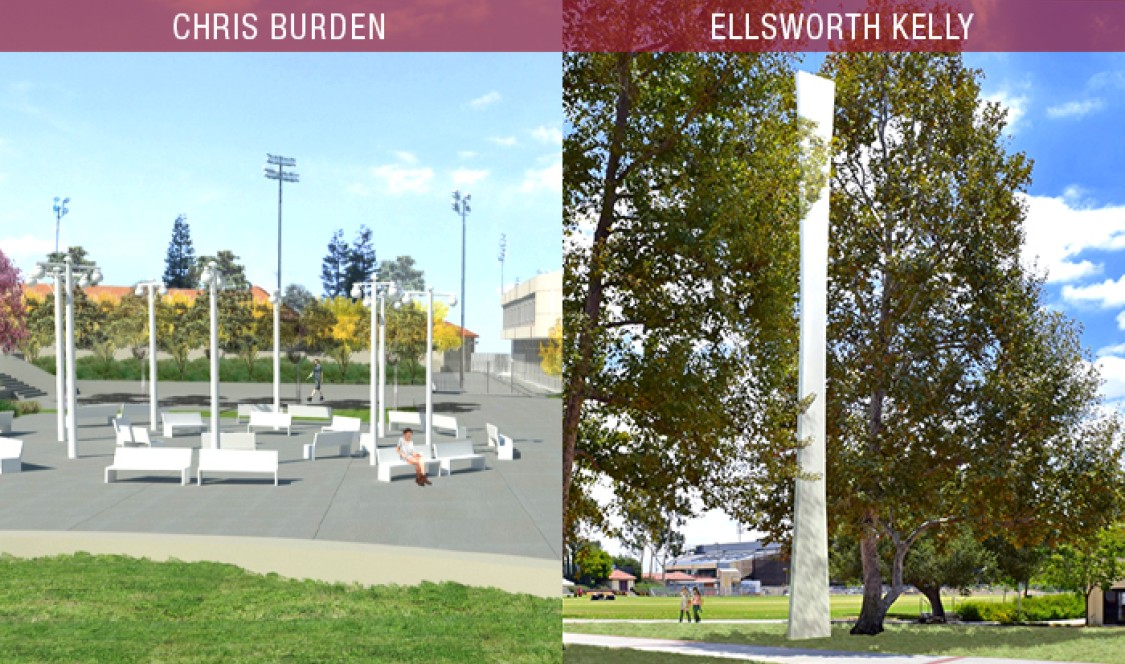Claremont McKenna College (CMC) announced the gift of two major sculptures from George Roberts ’66 P’93 by world-renowned artists Chris Burden and Ellsworth Kelly. The sculptures are the latest milestones in a major art and creativity initiative currently underway at Claremont McKenna. Burden’s work, Meet in the Middle, will be installed in May 2016 in front of the new Roberts Pavilion, a state-of-the-art fitness and events center for CMC and the athletic center for the Claremont-Mudd-Scripps intercollegiate, intramural, and physical education programs. The untitled Kelly piece, a unique totem sculpture, will be placed at the site of the original Story House on the campus in 2017.
“CMC is a special place in the world that continues to grow and excel, and it is a privilege to contribute to the College’s new public art initiative,” Roberts says. “We have a great community and these artworks will add a new dimension to CMC’s already excellent educational environment. Public art plays a special role in our lives, and CMC students will now have art in the spaces where they study, learn, and socialize.”
“We are very grateful to George Roberts for these inspiring gifts to the campus,” said Hiram Chodosh, President of Claremont McKenna College. “These extraordinary works by two great American artists will be iconic physical expressions of our deep commitment to creativity and its incalculable value in our society.”
Building on the installation last year of the painter Mary Weatherford’s monumental mural From the Mountain to the Sea in the Athenaeum, “the community-feel of the Burden piece and the sheer elegance of the sky-piercing Kelly totem will provide powerful complements to a series of related art and creativity endeavors,” according to Chodosh. The Claremont McKenna Public Art Committee, Student Arts Council, which showcases the work of student artists, the Gould Center’s leadership in bringing artists, curators, and art historians to campus, the Mellon Roundtables on Creativity, Empathy, and Courage, and the new Sontag Center for Collaborative Creativity, will each “mutually reinforce and draw inspiration from the significance of the Burden and Kelly sculptures,” Chodosh concluded.
The late Chris Burden, who was born in Boston, Massachusetts in 1946 and died in Topanga Canyon earlier this year, was known as an artist’s artist. Meet in the Middle, which will be installed outside of Roberts Pavilion, is a circular arrangement of eight street lamps and 24 benches. The sculpture will provide a point of focus and a recognizable meeting place. It was designed by the artist to be optimistic, welcoming, and provocative, and will provide a social setting where students and faculty can interact with the sculpture and each other. The lamps will automatically illuminate at sunset and turn off at sunrise and will be fitted with LED lights. Burden felt that these installations were about human relationships to the places we have built for ourselves: the posts and benches represent human scale, and they are more ornate than they need to be—small sculptures that dotted the streets of the past.
Meet in the Middle is part of a Burden body of work utilizing vintage street lamps. Urban Light, his 2008 large-scale assemblage sculpture of 202 restored L.A. street lamps from the 1920s and ‘30s, marks the entrance to the Los Angeles County Museum of Art. Many observers have declared the work an L.A. icon — a beacon of hope in the often-harsh urban landscape. Urban Light has appeared in films, music videos, commercials, TV shows, and national magazines.
Ellsworth Kelly has redefined abstraction in art, evading critical attempts to classify him as a color field, hard-edge or Minimalist painter, to establish himself as one of the most important artists working today. Kelly’s visual vocabulary draws from the world around him—shapes and colors found in plants, architecture, a shadow on a wall—and has been informed by his interest in the liminal space between places and objects, between his work and viewers. He has said, “In my world, I don’t want you to look at the surface; I want you to look at the form, the relationships."
A totem can be defined as an object imbued with spiritual significance, a place to gather and a place to reflect. Claremont McKenna has commissioned Ellsworth Kelly to create a unique totem sculpture, made of stainless steel, painted white, and approximately 40 feet in height. Like an Egyptian obelisk, the totem will serve as both a landmark and a place for contemplation. As is the case with much of his considerable body of work, these totems take as their point of departure shapes and patterns found in the natural world. Situated within a small grove of trees, the smooth, modern form will converse with its surroundings through the juxtaposition of the natural and the man made. Rising up above its surroundings, the totem will provide a space for self-reflection, dwarfing us in the presence of the towering pillar.
Kelly, who was born in Newburgh, N.Y., in 1923, lives and works in Spencertown, N.Y.
Renderings of the artworks can be seen here.

